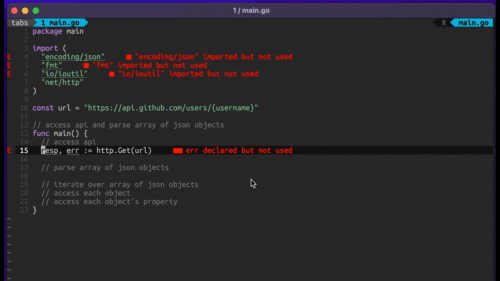
Four Key Reasons to Learn Markdown
Back-End Leveling UpWriting documentation is fun—really, really fun. I know some engineers may disagree with me, but as a technical writer, creating quality documentation that will...
Editor’s note: This post first appeared in a slightly different format on Jonathan’s personal blog.
Simplicity concerns concepts and divisions more that it does lines of code. But you probably didn’t hear that from Kelly Johnson, who coined this phrase:
Keep it simple, stupid.
The principle emphasizes that, contrary to what one might presume, complication isn’t a sign of brilliance; it signals a lack of investment. It shows the inability to break down and sift through the aspects of a problem domain to arrive at a solution that could be explained to a coworker in a couple of sentences.
The sad reality is that no tool can assess (or automate) simplicity; CodeClimate can’t tell me how well my knowledge boundaries are defined. Most of the time it does an impressive job at guessing through the causal relationship: a simpler model often yields simpler code.
But not always. That’s what you as a developer are employed to do: to keep it truly simple.
As the debate has moved away from the general principles of simplicity, we take them for granted. We perform code reviews and raise eyebrows (as we ought) when confronted with a mass of unreadable code and cryptic documentation.
But the intuition behind simplicity often conflicts with the bystanders’ definition.
Before the addition of ActiveSupport::Concern in Rails 4, many of us would have coded “behaviors” by hand in the lib directory. Statusable, Sortable, … most with trivial functionality that simply added an order scope or a few convenience methods. Consider a SearchMixin for adding basic search functionality across several fields:
module SearchMixin
def self.included(mod)
mod.extend ClassMethods
end
module ClassMethods
def searchable(*args)
@searchable = true
columns = args
search_string = columns.map {|c| "(#{c} LIKE :s)" }.join(" OR ")
class_eval <<-"END"
scope :search, lambda {|string| where('#{search_string}', :s => "%#{string}%") }
def self.searchable?
@searchable ||= false
@searchable
end
END
end
end
end
class ActiveRecord::Base
include SearchMixin
end
This mass of class evals effectively reduces a search scope declaration on a model from:
class Product < ActiveRecord::Base
scope :search,
lambda { |string| where(
'title LIKE :s OR description LIKE :s',
:s => "%#{string}%"
)}
end
Down to the more aesthetically pleasing:
class Product < ActiveRecord::Base
include SearchMixin
searchable :title, :description
end
Three observations: first, I don’t recommend you solve this particular problem with that implementation (class_eval can be evil, and your security-conscious co-workers may shun you). Still, the resultant model code is much nicer. Finally, it took a major sacrifice: we had to code, debug and think out an entirely new interface for declaring the same resultant implementation. The trade-off isn’t as sweet as we would like.
So the search functionality is simple, but there’s enough going on in that search method that we might convince our skeptics that the extraction is necessary to keep things simple (or DRY), say in the event we need to add several more fields or apply some field name sanitization. But what about a trivial behavior, like status? (Again, you probably shouldn’t implement such a feature this way…)
module StatusMixin
def active?
status.to_sym == :active
end
def inactive?
status.to_sym == :inactive
end
def status
super.to_s
end
def self.included(mod)
mod.extend ClassMethods
# Redefine the belongs_to method from the model's context
mod.singleton_class.send :define_method, :belongs_to_with_unscoped do |*args, &block|
# Call original belongs_to to setup actual association
belongs_to *args, &block # belongs_to_without_unscoped
# Setup unscoped method
association = args.first
klass = association.to_s.classify.constantize
class_eval <<-"END"
def #{association}_with_unscoped
# Fetch association with default scope disabled
#{klass}.unscoped { #{association}_without_unscoped }
end
alias_method_chain :#{association}, :unscoped
END
end
end
module ClassMethods
end
end
This example is not only longer, but does less: it really only adds a few one-liner methods for readability convenience.
Why trouble with Ruby metaprogramming to extract a few lines of code for a couple models? At that rate, why not extract every duplicate line of code into its own module?
For most of us, the former challenge would merit the canned response: “it’s easier to maintain and prevents duplication of knowledge.” Maybe our skeptics will swallow that reasoning in the first example, but probably not the second. It seems like we put KISS on hold for another date. Or did we?
We shouldn’t need to compromise between simplicity and ease of maintenance: in our quest for true simplicity, we should qualify what it accomplishes. What attributes of our code should it enhance?
Simple code should be simple to test: if behavior-driven development can’t get its fingers in the crannies, how can we expect another developer to extend or experiment with the code to understand it?
Consequently, nasty tests full of stubs and calls to #instance_variable_get are a quick indicator that the implementation architecture isn’t simple. Tests are part of your source code: if you had to take the same convoluted paths in implementing code for a model, it would trigger a refactor. The same goes for tests.
The simplification process should naturally encapsulate a domain of knowledge in one place. Thus, strictly domain related logic should be coded in that location, but once code becomes unruly, it is likely time to split the domain into new aspects or behaviors.
The strategy that arises from this principle keeps things DRY and tends towards the Single Responsibility Principle.
The side benefits from proper encapsulation inherently cross over into documentation.
A 1:1 ratio of code to inline comments is baaad.
Often the goal of extraction is to explain the knowledge structure and separation of behaviors with as few comments as possible, i.e., “self documenting” code.
By separating responsibilities into files, classes, modules and bundles (e.g., gems), boundaries in code begin to correspond with similar boundaries in the knowledge domain. Furthermore, each boundary becomes an opportunity for pertinent (but succinct) documentation.
At the bundle level (say a Github repo), we can attach a name (which doesn’t say much in gem land) and README to outline responsibilities at a high level. As developers dive into the source code, the modules and classes lend a useful context for understanding the architecture—even without explicit documentation.
Perhaps the less-obvious characteristic of simplicity is that it should point an ugly finger at chasms: if it’s hard to make something simpler, a key component or workflow (also simple) is missing.
This observation is exactly what led to the Rails framework! Trying to do hard things simply requires a bridge made entirely of simple units. Dedication to simplicity shows common needs that ought to be better handled.
Similarly, the search for stating knowledge boundaries simply leads to simplified methods. For example, ActiveSupport::Concern came out of the need to abstract class behaviors which were unrelated to the class’s main responsibility. Yet given the use-case, the implementation is incredibly straightforward (for Ruby metaprogramming at least):
# rails/activesupport/lib/active_support/concern.rb
module ActiveSupport
module Concern
def self.extended(base) #:nodoc:
base.instance_variable_set("@_dependencies", [])
end
def append_features(base)
if base.instance_variable_defined?("@_dependencies")
base.instance_variable_get("@_dependencies") << self
return false
else
return false if base < self
@_dependencies.each { |dep| base.send(:include, dep) }
super
base.extend const_get("ClassMethods") if const_defined?("ClassMethods")
base.class_eval(&@_included_block) if instance_variable_defined?("@_included_block")
end
end
def included(base = nil, &block)
if base.nil?
@_included_block = block
else
super
end
end
end
end
With a better understanding of real simplicity, behavioral modules likeSearchMixin have become our alibi in the pursuit of clean design.
Thanks to the principle of testing simplicity, we can unit test our SearchMixinfunctionality to make sure SQL injection attacks are mitigated.
Because of encapsulation, our code (which might have vulnerabilities) is in one logical place, is kept DRY, and succinctly defines the knowledge boundary of what it means for a model to be “searchable.”
With encapsulation documenting boundaries and keeping methods simple, we really don’t need many comments: our code is already understandable.
During the process, we realized how common it is to abstract behaviors in Ruby. Instead of tackling a few instances of the problem individually, we (or rather, the Rails core team) generalized the workflow into a reusable, unit-tested and documented feature.
That’s real simplicity. William of Ockham would approve.

Writing documentation is fun—really, really fun. I know some engineers may disagree with me, but as a technical writer, creating quality documentation that will...

Humanity has come a long way in its technological journey. We have reached the cusp of an age in which the concepts we have...

Go 1.18 has finally landed, and with it comes its own flavor of generics. In a previous post, we went over the accepted proposal and dove...